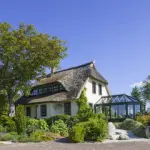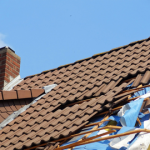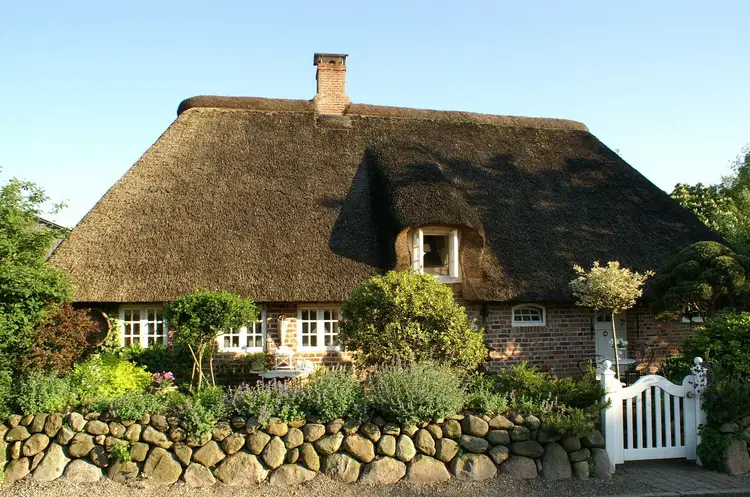
So you’ve found the perfect thatched roof property and weighing up whether to buy it or not. According to Savills, for its size, Dorset has more thatched houses than any other part of the UK. But The Netherlands has more thatched roof properties (150,000) than in the UK (60,000). A property with a thatched roof is considered non-standard construction. This is why it’s important to understand what are the pros and cons of a thatched roof property.
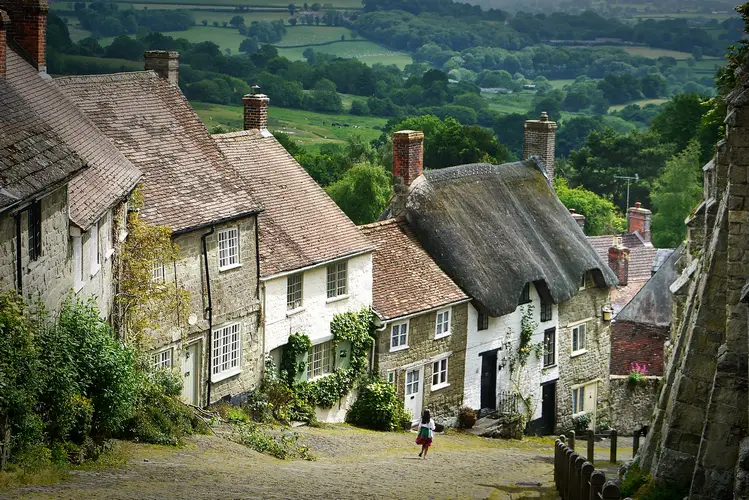
What are the pros of a thatched roof property
- Effective insulation for heat loss.
- Good insulation in the summer to keep house cool.
- Great sound insulation.
- Light weight material.
- Materials are sustainable.
- History and character.
- Charming and quaint.
Looking at each of these pros of buying a thatched roof house in more detail.
1. Thatched roofs offer an effective insulation for heat loss
The thatching on a house is very thick and is great insulation. This means that a thatched roof property will be warm in the winter and cheaper to heat. The windows are usually small too, which means there’s less heat loss from the windows on a thatched roof house. But see below, as this is also a con too.
2. Good insulation in the summer to keep house cool
In the summer months the thick layer of thatch provides good insulation against heat. This means that thatched roof houses will generally be cool on hot days of the summer. The walls are also often very thick, which helps to keep them cool in the summer too.
3. Great sound insulation
Any thatched roof property in the vicinity of an airport will also benefit from the sound insulation properties of the thatch too. Thatch is also a good sound insulator against road traffic noise too.
4. Thatching is light weight material
Despite the amount of thatching material required to make a thatched roof, the material is extremely light weight when compared to slate or tile. This means the roofing structure does not need to be as strong on a thatched cottage.
5. Thatching materials are sustainable
Thatched roofs are made from water reed, combed wheat reed and longstraw. All three of these thatching materials are environmentally friendly. The type of thatch material on the house will depend on what material was originally used that was local to the property.
Thatched roof properties come with history and character
If you like the idea of living in a part of history, a thatched roof property will provide this. You’ll be the next custodian of this old property, which some property owners love. A thatched roof property definitely has character when compared to a modern property that doesn’t have the associated history attached to old thatched houses.
Thatched houses are charming and quaint
There’s not getting away from the fact that houses with thatched roofs look lovely and are the quintessential British cottage style. They are both charming and quaint and as already mentioned, full of character.
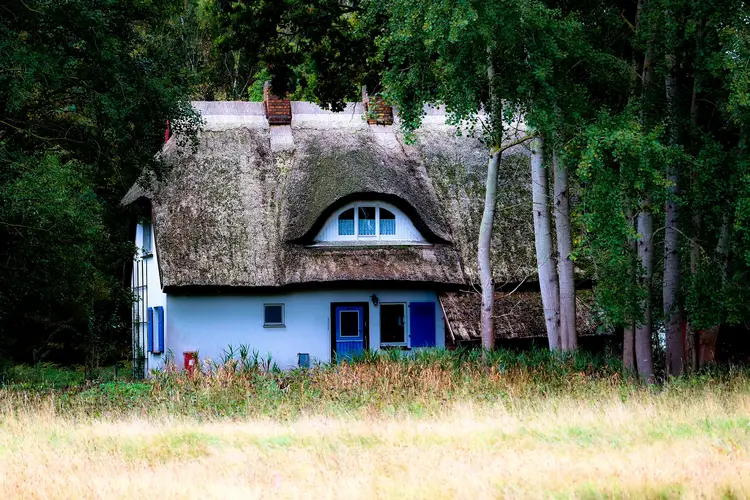
What are the cons of a thatched roof property?
- A Fire hazard.
- More expensive to insure.
- Expensive to replace and restore.
- Considerable ongoing repair costs.
- Don’t last as long as slate or tile roofs.
- Attract vermin, birds and insects.
- Most are devoice of natural light.
- Can leak in very heavy rainfall.
- Often have septic tanks for sewage drainage.
- Solid walls can cause rising amp problems.
- Don’t normally have gutters.
- Most are listed buildings.
- Mortgages are not as easy to obtain.
- Thatch can rot and there’s a risk of moss.
- Can be more difficult to sell.
Looking at each of these cons of buying a thatched roof house in more detail.
1. Thatch houses are a fire hazard
It is argued that thatched roof houses don’t catch fire any more than houses with tile and slate roofs. However, they are more of a fire hazard because once a fire starts in thatched roof house it will spread much quicker in thatch.
This fire hazard is increased if the thatch is covered by wire netting. This is because it will take the fire fighters longer to remove the thatch if it has wire netting covering the thatching material.
2. Thatch roof properties are more expensive to insure
Thatch roof properties are generally more expensive to insure when compared to conventional tile and slate roof houses. This can be as much as three times the cost for home and buildings insurance. The cost of insuring a thatched roof property is increased if the property has a wire netting covering the thatch.
3. Thatching is expensive to replace and restore
Thatching is a specialist skill and comes at a price. This means that when it comes to replace the thatch it will be expensive. It also depends on where the house is located as to the type of thatching used. Different types of thatching can last as little as 15 years or as long as 50 years.
4. Thatch roof properties have considerable ongoing repair costs
Due to the nature of the material of a thatched property the roof requires constant ongoing maintenance and repair. This is especially if the house is subject to long periods of wet weather or vermin and birds attack the thatching. The ridge of a thatch normally needs repairing every 8-10 years too.
5. Thatched roofs don’t last as long as slate or tile roofs
As thatching is made from plant material it’s prone to rot eventually. This means it will not last as long as slates and tiles, which of course will never rot over time.
6. Thatching material attract vermin, birds and insects, especially if not covered in wire netting
Thatching material can be irresistible to vermin like rats, mice and squirrels. They can burrow holes in the thatch and get into the house. Also, birds can pinch the thatching for nest building in the spring months. Not that you would really know, but thatching also harbours thousands of insects too.
7. Thatched properties tend to have smaller windows making them devoice of natural light
Most thatch properties are old and when they were constructed they tended to have small windows. The windows are also recessed into the thatch. This can make the rooms in a thatched roof property very dark. This is especially true of the roofs at the back of a thatch cottage with a north facing garden or a north east facing garden.
8. Thatch roofs can leak in very heavy rainfall
In very heavy rain storms a thatched roof can leak water. This is especially true if this ridge on the thatch is not replaced regularly. But on the whole a thatched roof is great at keeping water out. However, this is only if the thatch is in a good state of repair.
9. Thatched cottages are often in remote locations meaning they have septic tanks for sewage drainage
The location of many thatch roof houses means they may be on a septic tank, rather than on moans drainage. Not that this is a major problem, but some homebuyers don’t like septic tanks.
10. The walls on thatch roof houses are often solid walls and can cause rising amp problems
The walls on old thatch roof properties are often solid walls without a cavity. This can lead to damp problems as these walls often don’t have a damp proof course either. If you are going to buy a thatched roof property, make sure to have a surveyor check for damp.
11. Thatch roof properties don’t normally have guttering
Due to the fact that not many thatched roof houses have guttering this means the rain will cascade down around the house when it rains. This will usually continue for a while after it’s stopped raining too.
12. Most thatch roof properties are listed making them more expensive to update and maintain
Any property that is a listed building will be more expensive to update and maintain. This is because you may need to use specialist materials and specialist trades people too.
13. Mortgages are not as easy to obtain on thatch roof properties
The construction of thatch roof properties is non-standard, which includes the thatch roof itself. This means that obtaining a mortgage can be more difficult. As a result you may find the mortgage will cost more than a mortgage to buy a conventional slate or tiled roof property.
14. Thatch can rot and there’s a risk of moss
Thatching is plant material and as a result is prone to rot over time. This is especially a problem with prolonged periods or rain and damp weather. Moss and algae also like to grow on thatching too, which ends up looking unsightly and would make the property difficult to sell.
15. Can be more difficult to sell
Thatch roof properties are not for everyone which can make it more difficult to sell. This is because of the fire hazard, the extra cost to insure and the problems with getting mortgage too. But others don’t like the dark rooms in the house either.
I hope you’ve enjoyed this article about what are the pros and cons of a thatched roof property
If you’ve enjoyed this article about “what are the pros and cons of a thatched roof property” please share it on your favourite social media site.
Also, if you have any questions, please feel free to comment below too. Alternatively, if you need more help, please feel free to contact us on our contact us page here. Or join the discussion and ask your question in the property forum.

